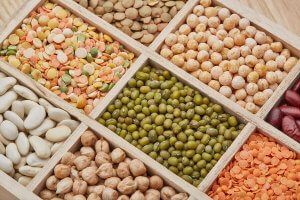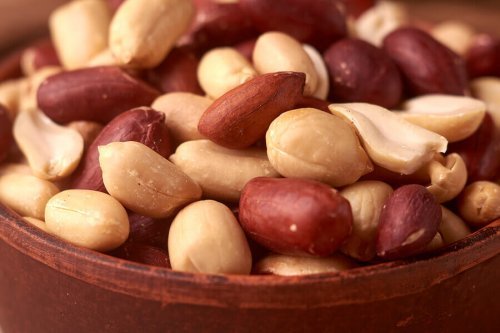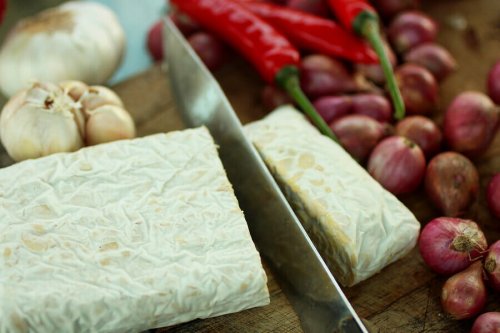All About Legumes

Legume is a general term used to describe the seeds of plants from the legume family. Legumes are a common and healthy part of many people’s diets all around the world.
Structure of legumes
The external appearance of legumes, or beans, varies depending on the bean, but they all have a similar structure. They’re dried seeds, separated from the pods where they grow, with a thin exterior protective layer called a seed coat.
This layer is edible and rich in fiber. Some varieties of beans separate their seed coat when you cook them. The inside of the bean is the seed, and it contains starch and proteins.
Classification of legumes
- Beans: there are many varieties in this category, such as pinto, black beans, and white beans, for example.
- Lentils: these small, round legumes come in a variety of sizes and colors. There are yellow lentils, red lentils, brown lentils, and black lentils.
- Garbanzo: these can be white, off-white, green, or black. They have a rough outer layer with a prominent point where the plant starts if you sprout the seed.
- Split peas: this legume is round and smooth. Fresh peas are green and split peas are yellow. In Spain, the green variety is most common.
- Lima beans: large, greenish-gray or brown legumes.
- Lupin beans: lupin, or lupini, can be white, yellow, or blue.
- Peanuts: eaten dry and roasted. Peanuts are the only legume that grows in the ground.

- Carob or locust bean: these are not eaten directly by humans. They’re mostly for direct animal consumption or processed into animal feed. They’re bigger than other legumes.
- Soy: soybeans look like round lentils. They’re light brown when dry, and bright green when fresh.
Products made from legumes
These foods are made from dry beans. They’re edible, either directly or as part of processed food. The Spanish Food Code classifies them as:
- Shucked legumes: these are the seeds without their seedpod.
- Legume purees: produced by crushing the dry seeds of legumes.
- Legume flours: produced by milling dry legumes.
Replace legumes with products made from soy
These foods aren’t part of the Spanish Food Code. Nevertheless, they’re a common part of many people’s diets, especially vegans. The following are included in this category:
Soy proteins
These are concentrates made from the proteins extracted from the defatted part of the soybean. People use soy protein in meat and dairy products, baby food, diet food, and vegan food (such as soy burgers).
Soy lecithin
This is a food additive and supplement.
Soy milk
Soy milk is made from soybeans. You can make soy milk at home, but on an industrial scale, it’s made by soaking soybeans in water to increase their volume, then crushing the seeds, heating them to almost boiling, pasteurizing them, and straining them.
A lot of people who are lactose intolerant or allergic to milk protein drink soy milk. Most kinds of soy milk you find in the supermarket are enriched with calcium and vitamins.

Tofu
Tofu is made from soy curds. Its texture is similar to queso fresco and a bland flavor. People usually marinate it with aromatic herbs or spices before they eat it.
Soy sauce
To make soy sauce, factories mix soy flour with toasted wheat and then moisten it and heat it. Then, they grind up that mixture, inoculate it with two different culturing molds, and leave it to ferment. Salt is added to the mixture and the lactic bacteria present in the mold causes fermentation. The final step is filtration and pasteurization.
Tempeh
Tempeh, made from fermented soy, is originally from Indonesia. It’s nutritional profile and the taste is different from tofu. It’s more firm than tofu and has a stronger flavor.

Tempeh is a great source of protein. Many vegetarians and vegans use it as a meat substitute.
Soy cheese
To make soy cheese, tofu is cut into strips and mixed with a saltwater solution. This mixture is inoculated with culturing mold and fermented for one to seventeen days.
Textured vegetable protein
Textured vegetable protein, or TVP, is made with defatted soy flour. Vegans and vegetarians use it as a substitute for ground beef.
In conclusion, from an ethical point of view, the consumption of legumes is much more sustainable than the consumption of animal products. Nutritionally, they contain more fiber, but less protein.
Legume is a general term used to describe the seeds of plants from the legume family. Legumes are a common and healthy part of many people’s diets all around the world.
Structure of legumes
The external appearance of legumes, or beans, varies depending on the bean, but they all have a similar structure. They’re dried seeds, separated from the pods where they grow, with a thin exterior protective layer called a seed coat.
This layer is edible and rich in fiber. Some varieties of beans separate their seed coat when you cook them. The inside of the bean is the seed, and it contains starch and proteins.
Classification of legumes
- Beans: there are many varieties in this category, such as pinto, black beans, and white beans, for example.
- Lentils: these small, round legumes come in a variety of sizes and colors. There are yellow lentils, red lentils, brown lentils, and black lentils.
- Garbanzo: these can be white, off-white, green, or black. They have a rough outer layer with a prominent point where the plant starts if you sprout the seed.
- Split peas: this legume is round and smooth. Fresh peas are green and split peas are yellow. In Spain, the green variety is most common.
- Lima beans: large, greenish-gray or brown legumes.
- Lupin beans: lupin, or lupini, can be white, yellow, or blue.
- Peanuts: eaten dry and roasted. Peanuts are the only legume that grows in the ground.

- Carob or locust bean: these are not eaten directly by humans. They’re mostly for direct animal consumption or processed into animal feed. They’re bigger than other legumes.
- Soy: soybeans look like round lentils. They’re light brown when dry, and bright green when fresh.
Products made from legumes
These foods are made from dry beans. They’re edible, either directly or as part of processed food. The Spanish Food Code classifies them as:
- Shucked legumes: these are the seeds without their seedpod.
- Legume purees: produced by crushing the dry seeds of legumes.
- Legume flours: produced by milling dry legumes.
Replace legumes with products made from soy
These foods aren’t part of the Spanish Food Code. Nevertheless, they’re a common part of many people’s diets, especially vegans. The following are included in this category:
Soy proteins
These are concentrates made from the proteins extracted from the defatted part of the soybean. People use soy protein in meat and dairy products, baby food, diet food, and vegan food (such as soy burgers).
Soy lecithin
This is a food additive and supplement.
Soy milk
Soy milk is made from soybeans. You can make soy milk at home, but on an industrial scale, it’s made by soaking soybeans in water to increase their volume, then crushing the seeds, heating them to almost boiling, pasteurizing them, and straining them.
A lot of people who are lactose intolerant or allergic to milk protein drink soy milk. Most kinds of soy milk you find in the supermarket are enriched with calcium and vitamins.

Tofu
Tofu is made from soy curds. Its texture is similar to queso fresco and a bland flavor. People usually marinate it with aromatic herbs or spices before they eat it.
Soy sauce
To make soy sauce, factories mix soy flour with toasted wheat and then moisten it and heat it. Then, they grind up that mixture, inoculate it with two different culturing molds, and leave it to ferment. Salt is added to the mixture and the lactic bacteria present in the mold causes fermentation. The final step is filtration and pasteurization.
Tempeh
Tempeh, made from fermented soy, is originally from Indonesia. It’s nutritional profile and the taste is different from tofu. It’s more firm than tofu and has a stronger flavor.

Tempeh is a great source of protein. Many vegetarians and vegans use it as a meat substitute.
Soy cheese
To make soy cheese, tofu is cut into strips and mixed with a saltwater solution. This mixture is inoculated with culturing mold and fermented for one to seventeen days.
Textured vegetable protein
Textured vegetable protein, or TVP, is made with defatted soy flour. Vegans and vegetarians use it as a substitute for ground beef.
In conclusion, from an ethical point of view, the consumption of legumes is much more sustainable than the consumption of animal products. Nutritionally, they contain more fiber, but less protein.
All cited sources were thoroughly reviewed by our team to ensure their quality, reliability, currency, and validity. The bibliography of this article was considered reliable and of academic or scientific accuracy.
- Alimentarius, C. (2013). Codex Alimentarius. Guidelines on Nutrition Labeling (CAC/GL 2-1985 (rev 1-1993)
This text is provided for informational purposes only and does not replace consultation with a professional. If in doubt, consult your specialist.








